Honor Award
University of Washington Service Learning International Design/Build Croatia 2011
Nick Boyce, Associate ASLA; Carlos Camara, Student ASLA; Wan Fong Wu, Student ASLA; Nell Gasiewicz, Student ASLA; Myles Harvey, Student ASLA; Derric Meister, Student Affiliate ASLA; Jimmy Mounivong, Associate ASLA; Teanna Quinn, Student Affiliate ASLA; Gherid Shmick, Student ASLA; Nicole Simon, Student ASLA; Mark Simonin, Student ASLA; Wuttiporn Taksinvarajarn, Student ASLA; Lori Tang, Student ASLA and Grace Vogal, Student ASLA, Undergraduate,
University of Washington
Faculty Advisor: Daniel Winterbottom, FASLA
 Close Me!
Close Me!COMMUNITY DESIGN BUILD, Rijeka, Croatia. Dormitory Ucenicki Dom Podmurvice provides housing for high school and college students from different regions of Croatia. The building formerly a monastery contained a church and community gardens. Patches of open space were yet to be realized and programmed.
Download Hi-Res ImageImage: Student Team
Image 1 of 15
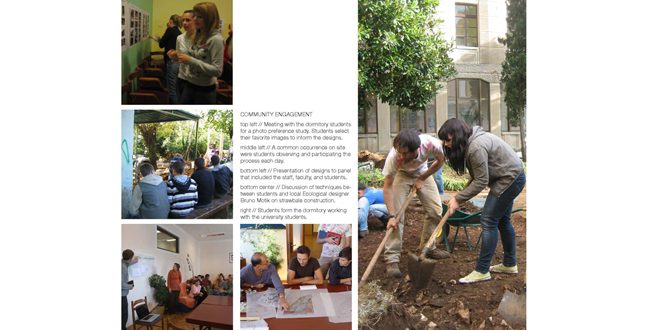 Close Me!
Close Me!Community Engagement. Top left: Meeting with the dormitory students for a photo preference study. Students select their favorite images to inform the designs. Middle left: A common occurrence on site were students observing and participating in the process each day. Bottom left: Presentation of designs to panel that included the staff, faculty, and students. Bottom center: Discussion of techniques between students and local Ecological designer Bruno Motik on strawbale construction. Right: Students from the dormitory working with the university students.
Download Hi-Res ImageImage: Student Team
Image 2 of 15
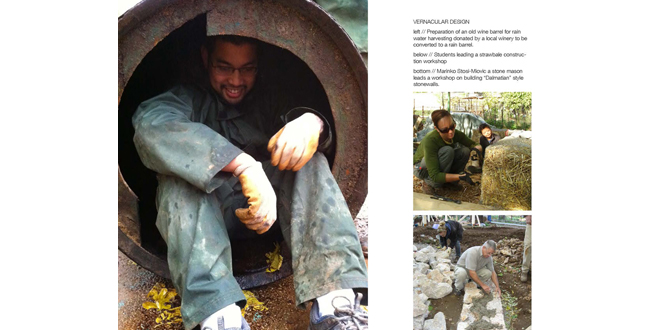 Close Me!
Close Me!Vernacular Design. Left: Preparation of an old wine barrel for rain water harvesting donated by a local winery to be converted to a rain barrel. Below: Students leading a strawbale construction workshop. Bottom: Marinko Stosi-Miovic a stone mason leads a workshop on building 'Dalmatian" style stonewalls.
Download Hi-Res ImageImage: Student Team
Image 3 of 15
 Close Me!
Close Me!Completed Gardens. Community Gathering Space. The final designs were based on an extensive iterative process that focused on a collaborative design development process. This process incorporated input from the dormitory students, staff, and faculty to inform the design and programming decisions. Image on bottom right shows existing site prior to construction.
Download Hi-Res ImageImage: Student Team
Image 4 of 15
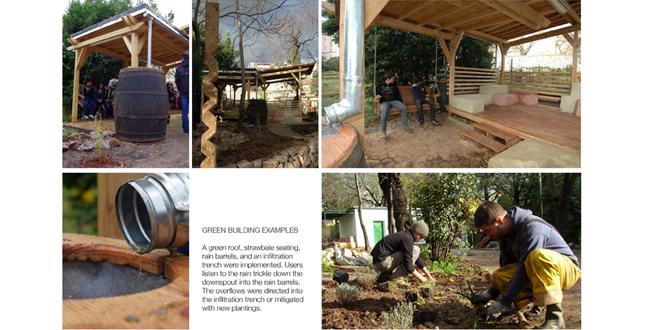 Close Me!
Close Me!Green Building Examples. A green roof, strawbale seating, rain barrels, and an infiltration trench were implemented. Users listen to the rain trickle down the downspout into the rain barrels. The overflows were directed into the infiltration trench or mitigated with new plantings.
Download Hi-Res ImageImage: Student Team
Image 5 of 15
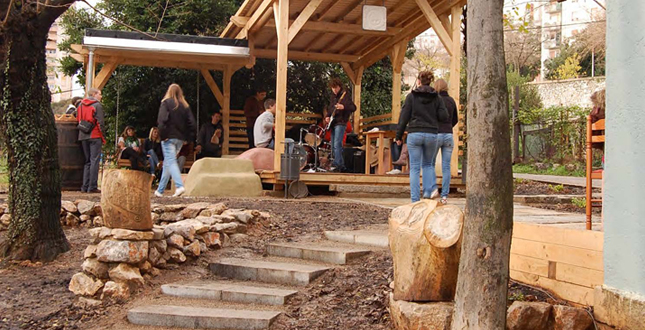 Close Me!
Close Me!Community Gathering Space. A timber framed shelter with, wood and stone paving and wood screening provides protection from inclement weather and a place for neighbors and students to meet, socialize and relax on strawbale benches or swing bench. The space provides a symbol for the dormitory as an “eko-dom” facility.
Download Hi-Res ImageImage: Student Team
Image 6 of 15
 Close Me!
Close Me!Reconciliation Garden. Reconciliation space is used by the dormitory residents to share experiences of prejudice and ethnic bigotory. The garden is an intimate area intended for reflection. As the plants mature the sense of privacy and reflection will be heightened. Bottom image shows the existing features of the site prior to site transformation.
Download Hi-Res ImageImage: Student Team
Image 7 of 15
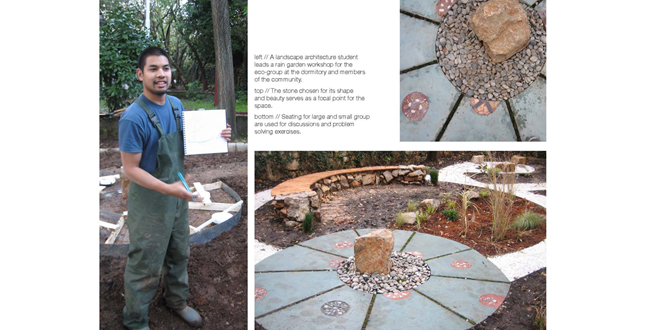 Close Me!
Close Me!Left: A landscape architecture student leads a rain garden workshop for the eco-group at the dormitory and members of the community. Top: The stone chosen for its shape and beauty serves as a focal point for the space. Bottom: Seating for large and small group are used for discussions and problem solving exercises.
Download Hi-Res ImageImage: Student Team
Image 8 of 15
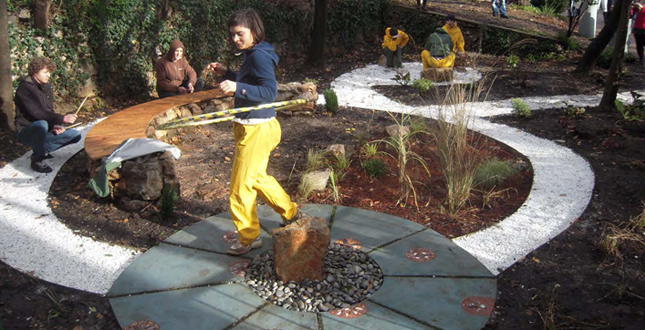 Close Me!
Close Me!A performance by local dancers and music suing elements of the site including the focal rock, curved stone wall bench, rain garden, and the private area.
Download Hi-Res ImageImage: Student Team
Image 9 of 15
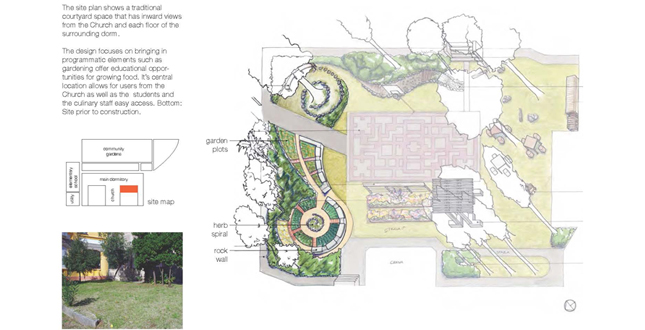 Close Me!
Close Me!Garden of Cultivation. The site plan shows a traditional courtyard space that has inward views from the Church and each floor of the surrounding dorm. The design focuses on bringing in programmatic elements such as gardening offer education opportunities for growing food. Its central location allows for users from the church as well as the students and the culinary staff easy access. Bottom: Site prior to construction.
Download Hi-Res ImageImage: Student Team
Image 10 of 15
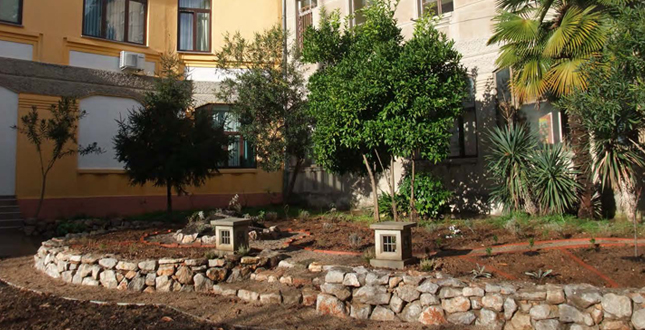 Close Me!
Close Me!Garden of Cultivation. The stone wall and herb spiral provides an elevation change as a counterpoint to the flat site. Red bricks outline each of the cultivation plots.
Download Hi-Res ImageImage: Student Team
Image 11 of 15
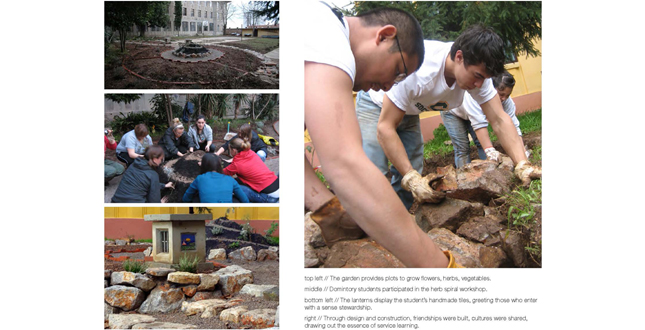 Close Me!
Close Me!Top left: The garden provides plots to grow flowers, herbs, vegetables. Middle: Dormitory students participated I the herb spiral workshop. Bottom left: the lanterns display the student’s handmade tiles, greeting those who enter with a sense stewardship. Right: Through design and construction, friendships were built, cultures were shared, drawing out the essence of service learning.
Download Hi-Res ImageImage: Student Team
Image 12 of 15
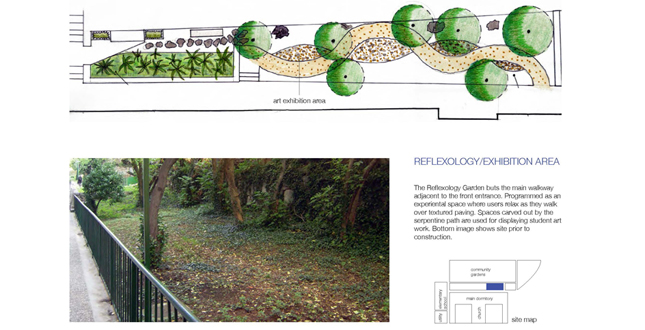 Close Me!REFLEXOLOGY / EXHIBITION AREA. The Reflexology Garden buts the main walkway adjacent to the front entrance. Programmed as an experimental space where users relax as they walk over textured paving. Spaces carved out by the serpentine path are used for displaying student art work. Bottom image shows site prior to construction.
Close Me!REFLEXOLOGY / EXHIBITION AREA. The Reflexology Garden buts the main walkway adjacent to the front entrance. Programmed as an experimental space where users relax as they walk over textured paving. Spaces carved out by the serpentine path are used for displaying student art work. Bottom image shows site prior to construction.
Download Hi-Res ImageImage: Student Team
Image 13 of 15
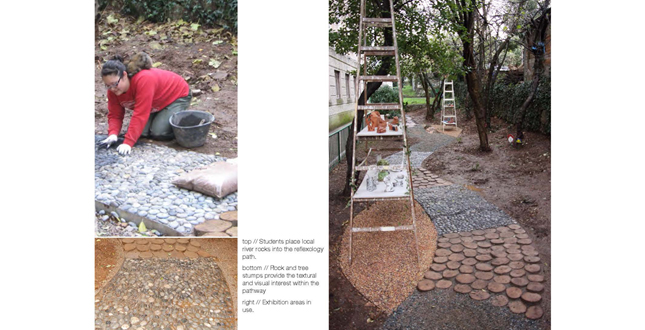 Close Me!
Close Me!Top: Students place local river rocks into the reflexology path. Bottom: rock and tree stumps provide the textural and visual interest within the pathway. Right: Exhibition areas in use.
Download Hi-Res ImageImage: Student Team
Image 14 of 15
 Close Me!
Close Me!Dedication Day. The provides a platform to showcase what was accomplished in 3 months as well as share the experiences of service as the dormitory and outside community came together. It was a project that could not have been done without the strong partnership between our design build team and the dormitory students, staff, and faculty, and local experts.
Download Hi-Res ImageImage: Student Team
Image 15 of 15
Project Statement
The youth of Croatia grapple with guilt, confusion and hopelessness in the debilitating aftermath of a corrosive war. To facilitate healing, a collaborative, community-based process was employed with the staff and students of Ucenicki Dom "Podmurvice: to design and build a series of outdoor therapeutic spaces. This project exemplifies how service learning can improve the quality of life for those transitioning from war to reconciliation by strengthening inclusion, ecological stewardship, and social change.
Project Narrative
—2011 Student Awards Jury
In 2010 sixteen students traveled to Rijeka, Croatia as part of our University's Service Learning International Design Build Program. In nine weeks the group, comprised of landscape architecture, architecture and civil engineering students from four different universities, designed and built four projects: a Community Gathering Space, Reconciliation Garden, Reflexology Path, and Cultivation Garden. The gardens offer four distinct therapeutic interactions with nature and as a whole address the need for social interactions, understanding, acceptance and increased spiritual and ecological health.
Client and Community Served
The Ucenicki Dom Dormitory provides housing for Croatian youth coming from rural parts of the country to attend high school and college in Rijeka. The clients included the students, staff and residents of the surrounding community who will use the new green spaces for gathering, walking, gardening and as a "green oasis: in a neighborhood of Yugoslavian era concrete residential towers. The gardens will also be used by parishioners and their children who attend mass in the church. That located on the dormitory grounds. Many of the dormitory residents come from towns bordering Bosnia and Serbia and experienced forced displacement and trauma resulting from the recent ethnic cleansing.
Landscape Design Principles
Our goal was to create a series of therapeutic spaces that relieve stress through aesthetic/sensory stimulation and distraction. A gardening program for the dormitory's eco-group and an exhibition area for artwork display were also developed. User needs were assessed from staff and resident surveys, in conjunction with focus groups, to create thematically organized preference boards. The resulting spaces offer a range of passive and active uses that provide nature/people interactions, social engagements, food cultivation and conflict resolution. The collaborative partnership between the dormitory and design/build program reflects a model of service learning that spans cultures and bridges differences. It fosters a greater acceptance and appreciation of diversity and personal struggles resulting in increased empathy among all participants. The project explored new terrain for Croatia, creating a unique and tangible example of therapeutic design, sustainable green building and community participation. This replicable model expands potential benefit to other communities suffering from similar traumas, displacements and conflict.
Community Benefits
Our service project provided multiple significant benefits to the Ucenicki Dom community and surrounding neighborhood residents. Foremost is the physical transformation of overgrown, unprogrammed and underused spaces into a cohesive series of linked spaces offering a range of uses. Spaces are provided for introspection, contemplation, reconciliation, social gathering, performance, gardening and art display. This physical transformation will be long lasting benefiting future generations and serves as a model that can be expanded, using green spaces to compliment other curriculum, social and ecological needs of the dormitory and neighborhood residents. Equally important was the community transformation in the participant's process of design. By achieving a shared vision, building enterprise and through impromptu interactions, both groups bridged cultural barriers, developed deep friendships and gained personal insights.
At the main entry into the dormitory grounds, the Community Gathering Space establishes a visual connection to the surrounding neighborhood. A timber framed covered shelter with, wood and stone paving and wood screening provides protection from inclement weather and a place for neighbors and students to meet, socialize and relax on strawbale benches or bench swing. Rainwater is collected from the metal roof for reuse and the green roof overflow is released into an infiltration swale. A series of dry stacked stone seat walls extending to the west from the shelter forms two open green "rooms: and references the ubiquitous vernacular stone walls that define the Dalmatian landscape. The eighty lineal feet of serpentine walls leads to the Reconciliation Garden at the dormitory entrance. This intimate space is used by small groups for conflict resolution, to discuss the ethnic and gender prejudice and discrimination which tore the country apart. The traditional forms are repeated in a curved stone bench that complements mosaic paving, rain garden, and clustered seat stones. As vegetation matures it will provide screening to augment the introspective and healing qualities of the space. Adjacent to the garden is the Reflexology and Exhibition Path, inviting visitors to experience the variation of paving textures including stone, wood, gravel, brick and moss with a range of colors reds, buffs, yellows white and gray. The aromatic plants and materials engage the senses, hearing, touch and site. The body relaxes through the natural massaging of the feet as users negotiate the path in bare feet. This calming, meditative space also functions as an art exhibition area.
At the interior courtyard, is the Garden of Cultivation where students grow and harvest herbs and vegetables. Growing fresh produce reduces daily stresses, a hopeful foil to traumatizing memories. The focal point is an herb spiral, a symbolic, spiritual landscape reference, adjacent to the side entry to the church.
This project reflects innovation, determination and the ethic of service at its most intense level. Many humanitarian organizations have left the Balkans, but the pain of war has not retreated from the people of Croatia. Accepting healing and moving forward are critical for the youth of Croatia. This project will facilitate that process. It actively embodies the ecological and social principles at the core of our profession and demonstrates a strong service ethic that can and should be at the core of our landscape architectural education.
Additional Project Credits
University of Washington Design Build Team Croatia: Landscape Architecture Students
Jimmy Mounivong; Myles Harvey; Nick Boyce; Carlos Camara; Nicole Simon; Lori Tang; Gherid Shmick; Wan Fong Wu; Hugh Hedin; Wuttiporn; Taksinvarajarn; Mark Simonin; Grace Vogal; Nell Gasiewicz
Civil Engineer Student
Alfred Deichsel
Architecture Student
Derric Meister
Urban Planning Student
Teanna Delmater
Landscape Design & Build Project Leadership
Ljiljana Kencel, Učenički dom Director
Croatia Landscape Design Consultant & Project Coordinator
Marina Butorac
Croatian Professional Consultants:
Stone Sitting Walls
Marinko Stoši-Miović
Ecological Design Consultant
Bruno Motik
Stone Carving
Dubrayko Radman
Construction Consultation
Mirko and Darinko
Mural Artist
Vojo Radojičić
Special thanks to Učenički domEco Group and Svjetlana Brnobić






